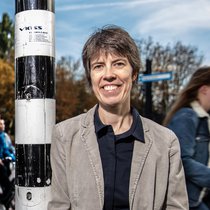Urban mobility
The Urban Mobility Observatory (UMO) is an extensive system of sensors and IT infrastructure for observing mobility and travel behavior and combining data from different kinds of measurements (cameras, mobile phones, surveys). UMO will collect and save all manner of traffic, transport and mobility data and make it available for research into mobility and transport in urban areas. ‘This is pressing because understanding and managing the rapid developments in transport in these areas calls for new observations’, says principal applicant Dr. Winnie Daamen (TU Delft).
Collaboration
The grant of 1.95 million euros (for a period of five years) will be topped up by the eight participating parties to 3.25 million euros.
“We are very happy with this extensive collaboration. The large number of partners and generous individual contributions show the will to work together. This will allow us to involve all kinds of researchers with different perspectives. UMO makes ground-breaking scientific research possible in the area of traffic, transport, and mobility.”
Winnie Daamen
Associate Professor
Researchers are welcome to submit plans for the collection of new data. We will work with existing data as well (including data from external parties). The effective filtering of that data is one of the main tasks.
Sensors and apps
UMO's network of sensors will contain instruments for monitoring real-life situations in six regions (including cameras, radar, LIDARs, BT/Wi-Fi trackers, and mobile apps). There is also a moving network of sensors via vehicles and moveable devices for additional observations.
Certain data on travel behaviour and travel preferences will be collected via crowdsourcing (a panel) and social media, for instance. Data will be continuously collected on a representative average of the Dutch population. ‘This will also include tracking the same people for several years and watching how their mobility and travel behaviour changes’
The Netherlands
The campus in Delft will be one of the research areas. ‘The Netherlands is the perfect location for UMO’, says Daamen. ‘It is one of the most densely populated countries in the world, with huge accessibility problems and heavy impact on the environment by traffic. In addition, our country has a strong tradition of collaboration on research and an excellent international reputation in transport research.’
The data collected by UMO will be made accessible to the public as much as possible, with the necessary privacy safeguards, of course.
The eight partners in Urban Mobility Observatory: TU Delft, TU Eindhoven, VU Amsterdam, Utrecht University, University of Twente, University of Groningen, AMS Institute and CWI.
